SWOT Analysis of Morrisons Supermarkets
VerifiedAdded on 2020/10/23
|9
|2716
|318
AI Summary
The provided report conducts a SWOT analysis of Morrisons Supermarkets, highlighting the company's strengths in providing job satisfaction to employees and its weaknesses in complying with various laws. The analysis also identifies opportunities for the company to survive in a competitive market and concludes that internal and external analysis is necessary to determine strength, weakness, opportunity, and threat factors.
Contribute Materials
Your contribution can guide someone’s learning journey. Share your
documents today.
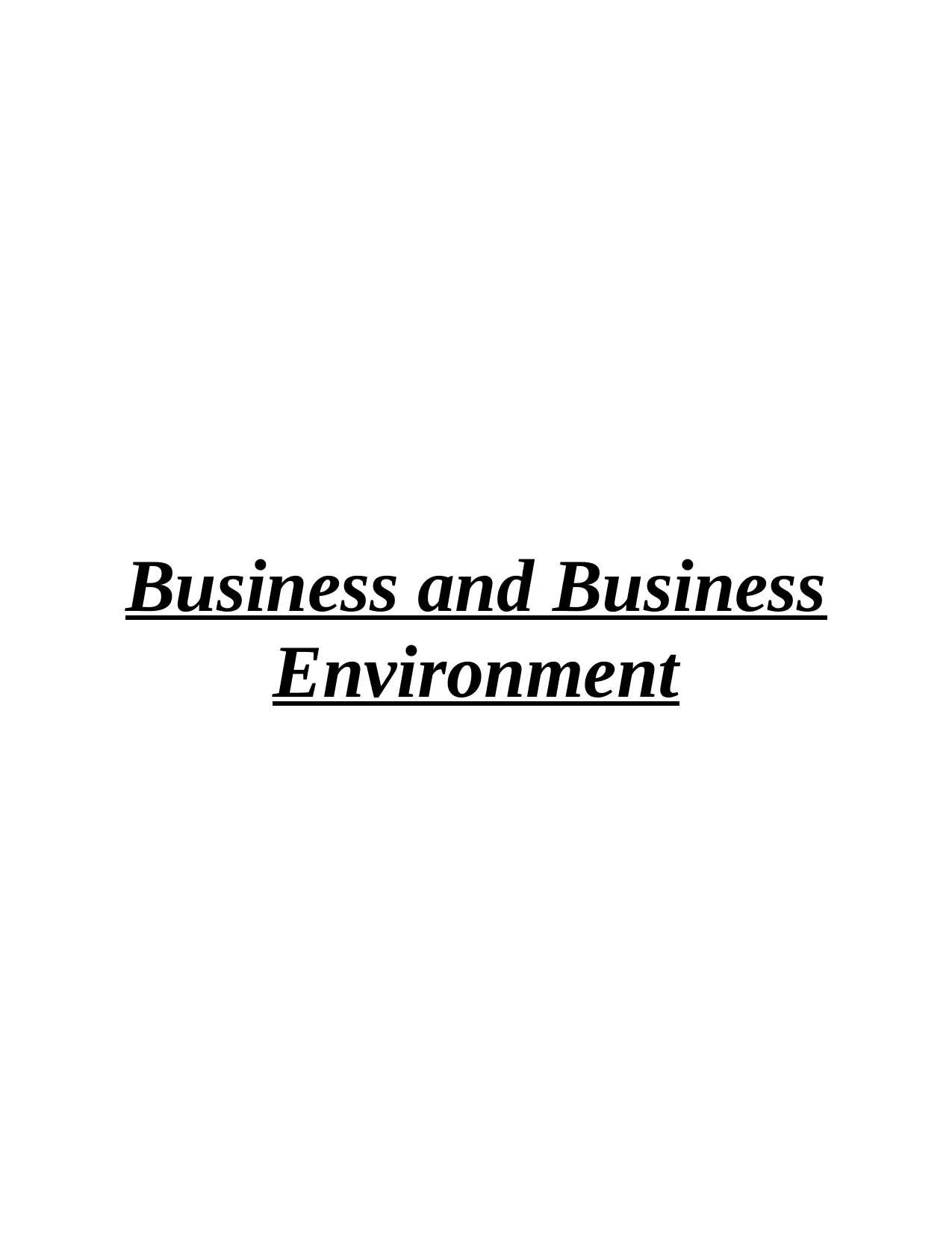
Business and Business
Environment
Environment
Secure Best Marks with AI Grader
Need help grading? Try our AI Grader for instant feedback on your assignments.
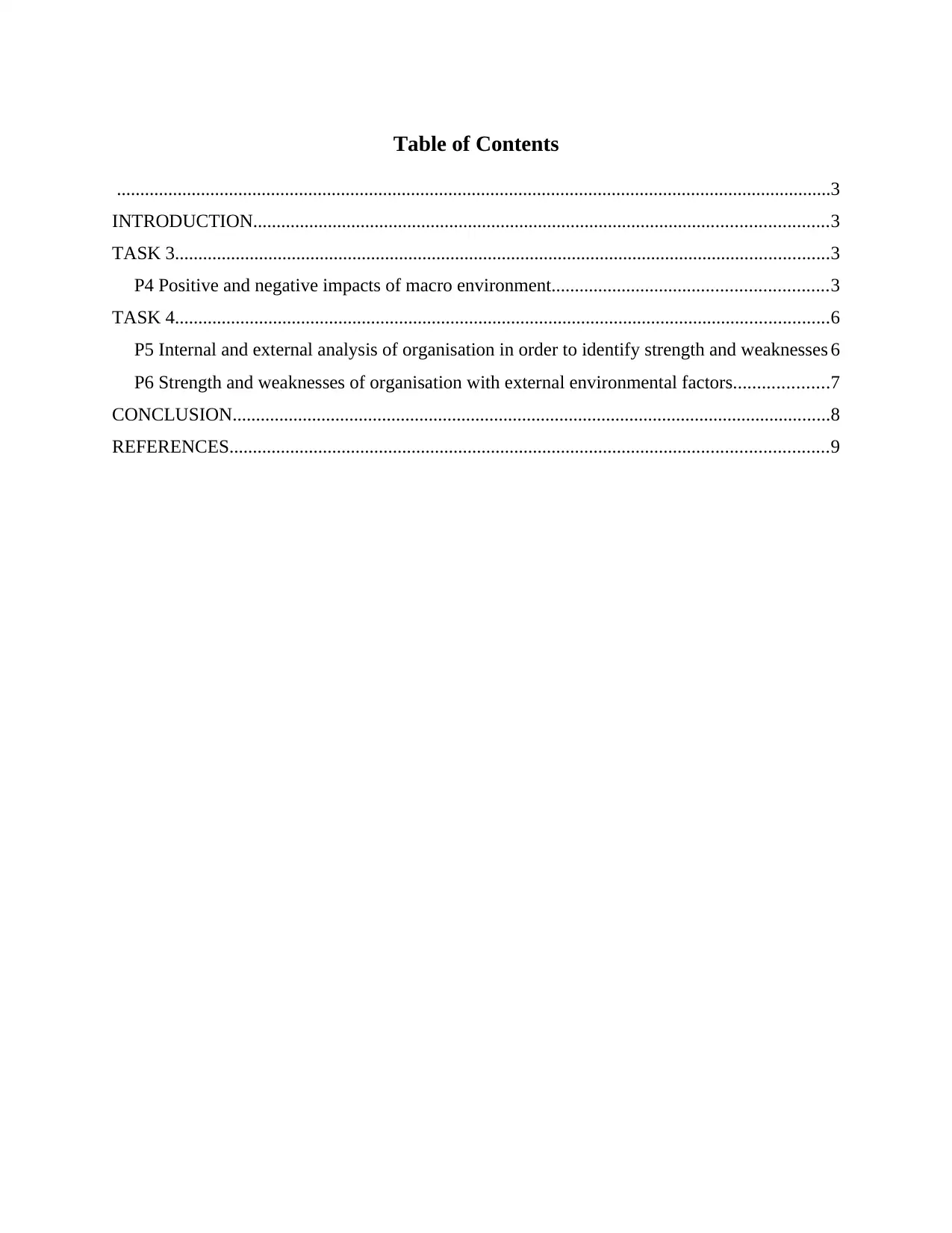
Table of Contents
.........................................................................................................................................................3
INTRODUCTION...........................................................................................................................3
TASK 3............................................................................................................................................3
P4 Positive and negative impacts of macro environment...........................................................3
TASK 4............................................................................................................................................6
P5 Internal and external analysis of organisation in order to identify strength and weaknesses 6
P6 Strength and weaknesses of organisation with external environmental factors....................7
CONCLUSION................................................................................................................................8
REFERENCES................................................................................................................................9
.........................................................................................................................................................3
INTRODUCTION...........................................................................................................................3
TASK 3............................................................................................................................................3
P4 Positive and negative impacts of macro environment...........................................................3
TASK 4............................................................................................................................................6
P5 Internal and external analysis of organisation in order to identify strength and weaknesses 6
P6 Strength and weaknesses of organisation with external environmental factors....................7
CONCLUSION................................................................................................................................8
REFERENCES................................................................................................................................9
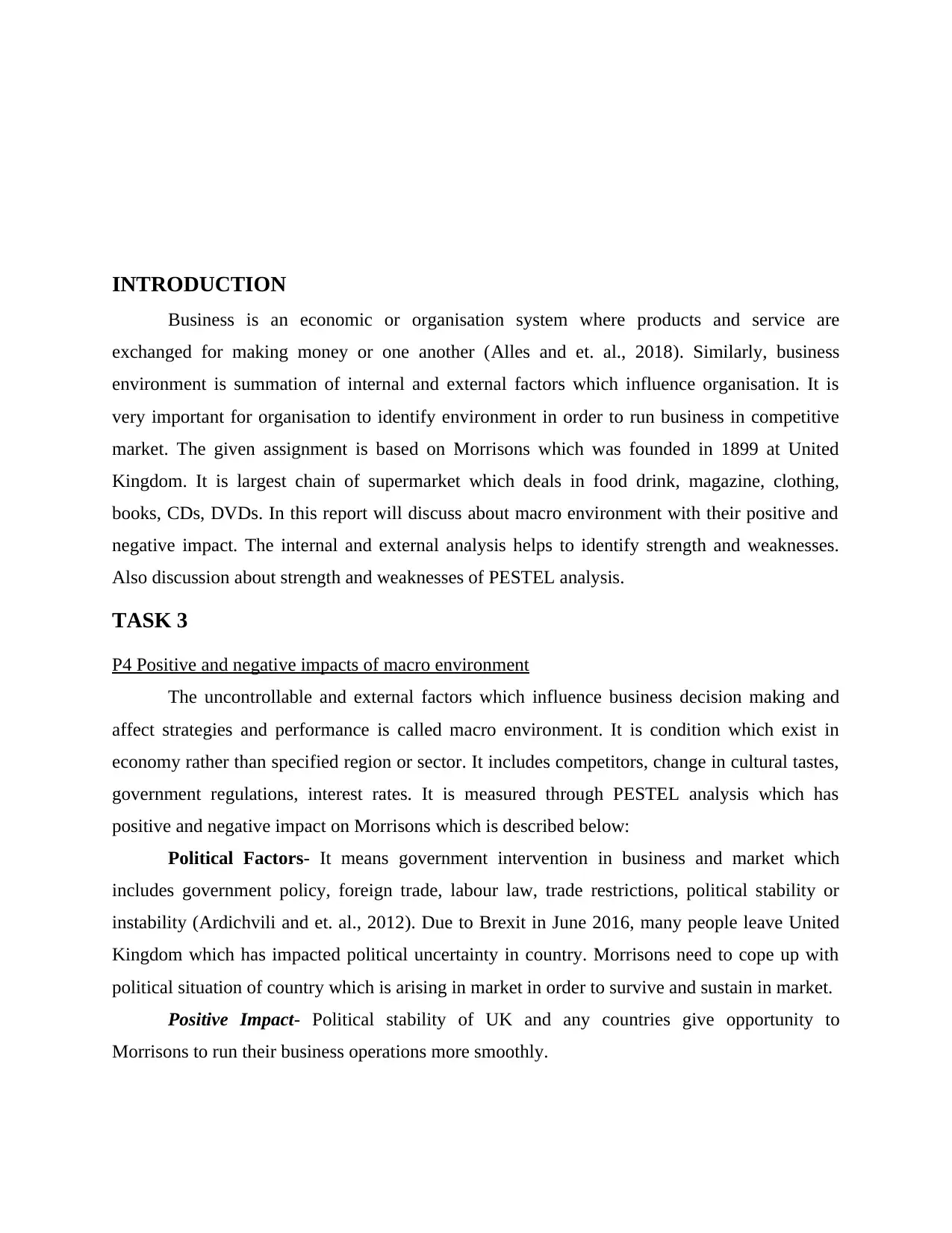
INTRODUCTION
Business is an economic or organisation system where products and service are
exchanged for making money or one another (Alles and et. al., 2018). Similarly, business
environment is summation of internal and external factors which influence organisation. It is
very important for organisation to identify environment in order to run business in competitive
market. The given assignment is based on Morrisons which was founded in 1899 at United
Kingdom. It is largest chain of supermarket which deals in food drink, magazine, clothing,
books, CDs, DVDs. In this report will discuss about macro environment with their positive and
negative impact. The internal and external analysis helps to identify strength and weaknesses.
Also discussion about strength and weaknesses of PESTEL analysis.
TASK 3
P4 Positive and negative impacts of macro environment
The uncontrollable and external factors which influence business decision making and
affect strategies and performance is called macro environment. It is condition which exist in
economy rather than specified region or sector. It includes competitors, change in cultural tastes,
government regulations, interest rates. It is measured through PESTEL analysis which has
positive and negative impact on Morrisons which is described below:
Political Factors- It means government intervention in business and market which
includes government policy, foreign trade, labour law, trade restrictions, political stability or
instability (Ardichvili and et. al., 2012). Due to Brexit in June 2016, many people leave United
Kingdom which has impacted political uncertainty in country. Morrisons need to cope up with
political situation of country which is arising in market in order to survive and sustain in market.
Positive Impact- Political stability of UK and any countries give opportunity to
Morrisons to run their business operations more smoothly.
Business is an economic or organisation system where products and service are
exchanged for making money or one another (Alles and et. al., 2018). Similarly, business
environment is summation of internal and external factors which influence organisation. It is
very important for organisation to identify environment in order to run business in competitive
market. The given assignment is based on Morrisons which was founded in 1899 at United
Kingdom. It is largest chain of supermarket which deals in food drink, magazine, clothing,
books, CDs, DVDs. In this report will discuss about macro environment with their positive and
negative impact. The internal and external analysis helps to identify strength and weaknesses.
Also discussion about strength and weaknesses of PESTEL analysis.
TASK 3
P4 Positive and negative impacts of macro environment
The uncontrollable and external factors which influence business decision making and
affect strategies and performance is called macro environment. It is condition which exist in
economy rather than specified region or sector. It includes competitors, change in cultural tastes,
government regulations, interest rates. It is measured through PESTEL analysis which has
positive and negative impact on Morrisons which is described below:
Political Factors- It means government intervention in business and market which
includes government policy, foreign trade, labour law, trade restrictions, political stability or
instability (Ardichvili and et. al., 2012). Due to Brexit in June 2016, many people leave United
Kingdom which has impacted political uncertainty in country. Morrisons need to cope up with
political situation of country which is arising in market in order to survive and sustain in market.
Positive Impact- Political stability of UK and any countries give opportunity to
Morrisons to run their business operations more smoothly.
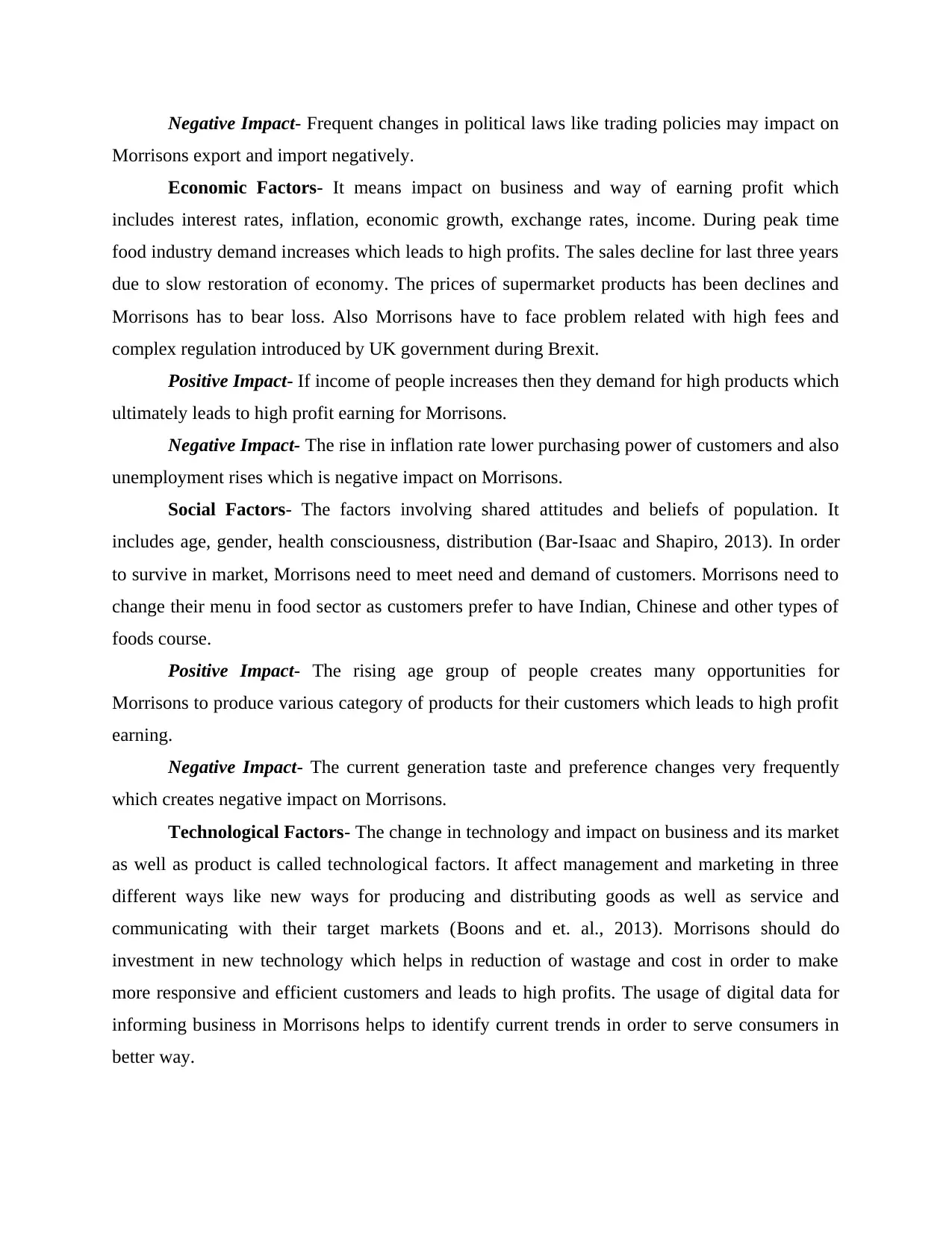
Negative Impact- Frequent changes in political laws like trading policies may impact on
Morrisons export and import negatively.
Economic Factors- It means impact on business and way of earning profit which
includes interest rates, inflation, economic growth, exchange rates, income. During peak time
food industry demand increases which leads to high profits. The sales decline for last three years
due to slow restoration of economy. The prices of supermarket products has been declines and
Morrisons has to bear loss. Also Morrisons have to face problem related with high fees and
complex regulation introduced by UK government during Brexit.
Positive Impact- If income of people increases then they demand for high products which
ultimately leads to high profit earning for Morrisons.
Negative Impact- The rise in inflation rate lower purchasing power of customers and also
unemployment rises which is negative impact on Morrisons.
Social Factors- The factors involving shared attitudes and beliefs of population. It
includes age, gender, health consciousness, distribution (Bar-Isaac and Shapiro, 2013). In order
to survive in market, Morrisons need to meet need and demand of customers. Morrisons need to
change their menu in food sector as customers prefer to have Indian, Chinese and other types of
foods course.
Positive Impact- The rising age group of people creates many opportunities for
Morrisons to produce various category of products for their customers which leads to high profit
earning.
Negative Impact- The current generation taste and preference changes very frequently
which creates negative impact on Morrisons.
Technological Factors- The change in technology and impact on business and its market
as well as product is called technological factors. It affect management and marketing in three
different ways like new ways for producing and distributing goods as well as service and
communicating with their target markets (Boons and et. al., 2013). Morrisons should do
investment in new technology which helps in reduction of wastage and cost in order to make
more responsive and efficient customers and leads to high profits. The usage of digital data for
informing business in Morrisons helps to identify current trends in order to serve consumers in
better way.
Morrisons export and import negatively.
Economic Factors- It means impact on business and way of earning profit which
includes interest rates, inflation, economic growth, exchange rates, income. During peak time
food industry demand increases which leads to high profits. The sales decline for last three years
due to slow restoration of economy. The prices of supermarket products has been declines and
Morrisons has to bear loss. Also Morrisons have to face problem related with high fees and
complex regulation introduced by UK government during Brexit.
Positive Impact- If income of people increases then they demand for high products which
ultimately leads to high profit earning for Morrisons.
Negative Impact- The rise in inflation rate lower purchasing power of customers and also
unemployment rises which is negative impact on Morrisons.
Social Factors- The factors involving shared attitudes and beliefs of population. It
includes age, gender, health consciousness, distribution (Bar-Isaac and Shapiro, 2013). In order
to survive in market, Morrisons need to meet need and demand of customers. Morrisons need to
change their menu in food sector as customers prefer to have Indian, Chinese and other types of
foods course.
Positive Impact- The rising age group of people creates many opportunities for
Morrisons to produce various category of products for their customers which leads to high profit
earning.
Negative Impact- The current generation taste and preference changes very frequently
which creates negative impact on Morrisons.
Technological Factors- The change in technology and impact on business and its market
as well as product is called technological factors. It affect management and marketing in three
different ways like new ways for producing and distributing goods as well as service and
communicating with their target markets (Boons and et. al., 2013). Morrisons should do
investment in new technology which helps in reduction of wastage and cost in order to make
more responsive and efficient customers and leads to high profits. The usage of digital data for
informing business in Morrisons helps to identify current trends in order to serve consumers in
better way.
Secure Best Marks with AI Grader
Need help grading? Try our AI Grader for instant feedback on your assignments.
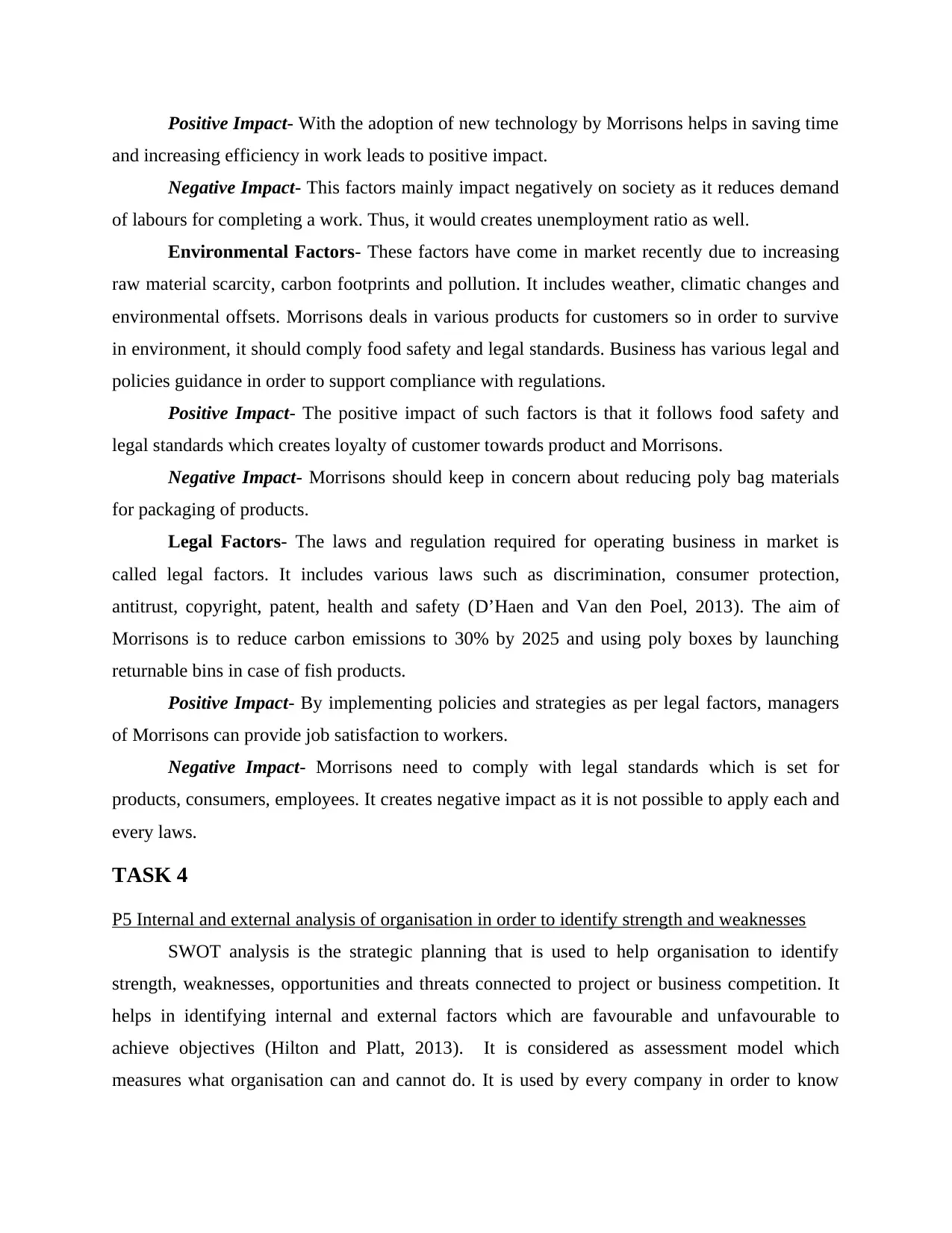
Positive Impact- With the adoption of new technology by Morrisons helps in saving time
and increasing efficiency in work leads to positive impact.
Negative Impact- This factors mainly impact negatively on society as it reduces demand
of labours for completing a work. Thus, it would creates unemployment ratio as well.
Environmental Factors- These factors have come in market recently due to increasing
raw material scarcity, carbon footprints and pollution. It includes weather, climatic changes and
environmental offsets. Morrisons deals in various products for customers so in order to survive
in environment, it should comply food safety and legal standards. Business has various legal and
policies guidance in order to support compliance with regulations.
Positive Impact- The positive impact of such factors is that it follows food safety and
legal standards which creates loyalty of customer towards product and Morrisons.
Negative Impact- Morrisons should keep in concern about reducing poly bag materials
for packaging of products.
Legal Factors- The laws and regulation required for operating business in market is
called legal factors. It includes various laws such as discrimination, consumer protection,
antitrust, copyright, patent, health and safety (D’Haen and Van den Poel, 2013). The aim of
Morrisons is to reduce carbon emissions to 30% by 2025 and using poly boxes by launching
returnable bins in case of fish products.
Positive Impact- By implementing policies and strategies as per legal factors, managers
of Morrisons can provide job satisfaction to workers.
Negative Impact- Morrisons need to comply with legal standards which is set for
products, consumers, employees. It creates negative impact as it is not possible to apply each and
every laws.
TASK 4
P5 Internal and external analysis of organisation in order to identify strength and weaknesses
SWOT analysis is the strategic planning that is used to help organisation to identify
strength, weaknesses, opportunities and threats connected to project or business competition. It
helps in identifying internal and external factors which are favourable and unfavourable to
achieve objectives (Hilton and Platt, 2013). It is considered as assessment model which
measures what organisation can and cannot do. It is used by every company in order to know
and increasing efficiency in work leads to positive impact.
Negative Impact- This factors mainly impact negatively on society as it reduces demand
of labours for completing a work. Thus, it would creates unemployment ratio as well.
Environmental Factors- These factors have come in market recently due to increasing
raw material scarcity, carbon footprints and pollution. It includes weather, climatic changes and
environmental offsets. Morrisons deals in various products for customers so in order to survive
in environment, it should comply food safety and legal standards. Business has various legal and
policies guidance in order to support compliance with regulations.
Positive Impact- The positive impact of such factors is that it follows food safety and
legal standards which creates loyalty of customer towards product and Morrisons.
Negative Impact- Morrisons should keep in concern about reducing poly bag materials
for packaging of products.
Legal Factors- The laws and regulation required for operating business in market is
called legal factors. It includes various laws such as discrimination, consumer protection,
antitrust, copyright, patent, health and safety (D’Haen and Van den Poel, 2013). The aim of
Morrisons is to reduce carbon emissions to 30% by 2025 and using poly boxes by launching
returnable bins in case of fish products.
Positive Impact- By implementing policies and strategies as per legal factors, managers
of Morrisons can provide job satisfaction to workers.
Negative Impact- Morrisons need to comply with legal standards which is set for
products, consumers, employees. It creates negative impact as it is not possible to apply each and
every laws.
TASK 4
P5 Internal and external analysis of organisation in order to identify strength and weaknesses
SWOT analysis is the strategic planning that is used to help organisation to identify
strength, weaknesses, opportunities and threats connected to project or business competition. It
helps in identifying internal and external factors which are favourable and unfavourable to
achieve objectives (Hilton and Platt, 2013). It is considered as assessment model which
measures what organisation can and cannot do. It is used by every company in order to know
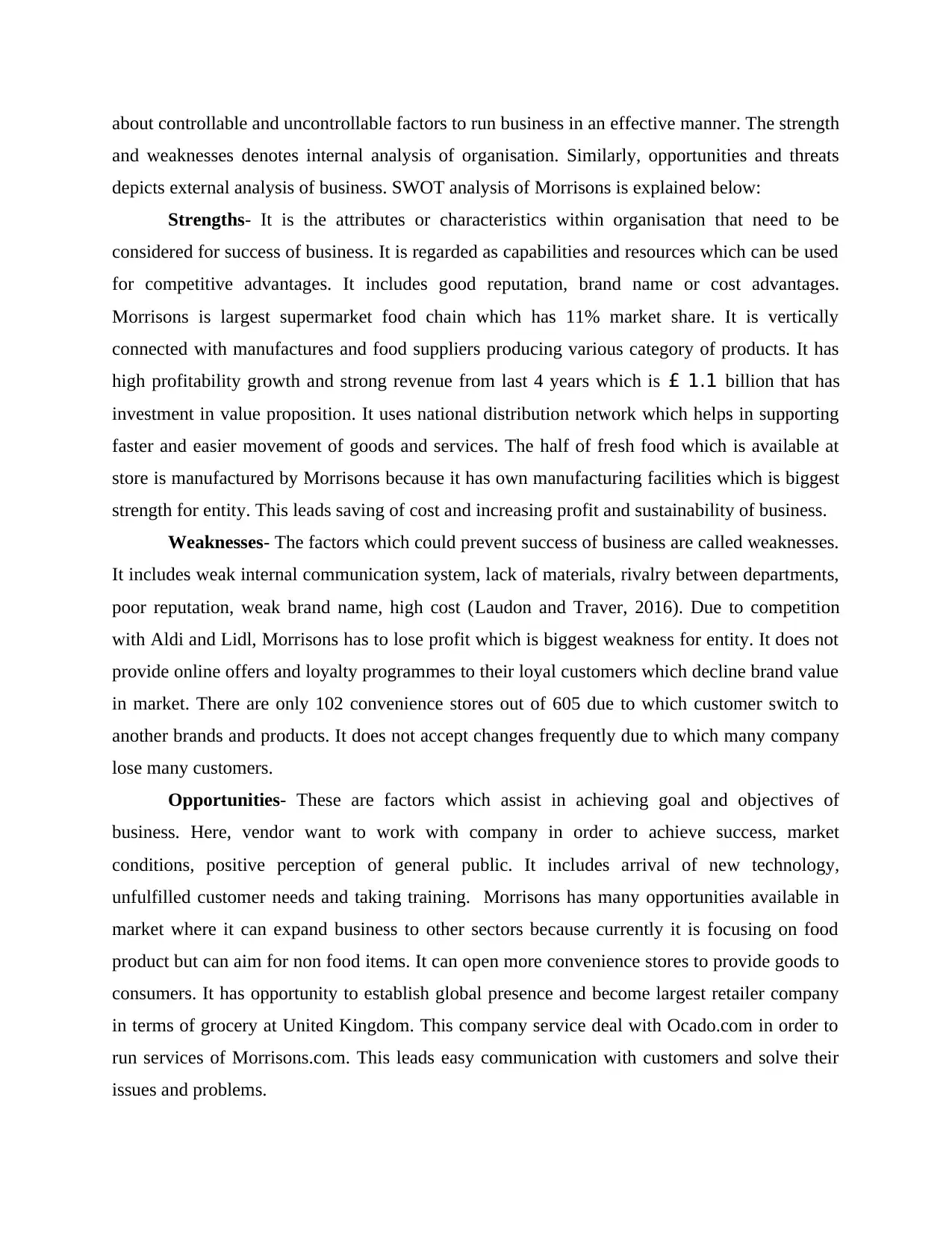
about controllable and uncontrollable factors to run business in an effective manner. The strength
and weaknesses denotes internal analysis of organisation. Similarly, opportunities and threats
depicts external analysis of business. SWOT analysis of Morrisons is explained below:
Strengths- It is the attributes or characteristics within organisation that need to be
considered for success of business. It is regarded as capabilities and resources which can be used
for competitive advantages. It includes good reputation, brand name or cost advantages.
Morrisons is largest supermarket food chain which has 11% market share. It is vertically
connected with manufactures and food suppliers producing various category of products. It has
high profitability growth and strong revenue from last 4 years which is £ 1.1 billion that has
investment in value proposition. It uses national distribution network which helps in supporting
faster and easier movement of goods and services. The half of fresh food which is available at
store is manufactured by Morrisons because it has own manufacturing facilities which is biggest
strength for entity. This leads saving of cost and increasing profit and sustainability of business.
Weaknesses- The factors which could prevent success of business are called weaknesses.
It includes weak internal communication system, lack of materials, rivalry between departments,
poor reputation, weak brand name, high cost (Laudon and Traver, 2016). Due to competition
with Aldi and Lidl, Morrisons has to lose profit which is biggest weakness for entity. It does not
provide online offers and loyalty programmes to their loyal customers which decline brand value
in market. There are only 102 convenience stores out of 605 due to which customer switch to
another brands and products. It does not accept changes frequently due to which many company
lose many customers.
Opportunities- These are factors which assist in achieving goal and objectives of
business. Here, vendor want to work with company in order to achieve success, market
conditions, positive perception of general public. It includes arrival of new technology,
unfulfilled customer needs and taking training. Morrisons has many opportunities available in
market where it can expand business to other sectors because currently it is focusing on food
product but can aim for non food items. It can open more convenience stores to provide goods to
consumers. It has opportunity to establish global presence and become largest retailer company
in terms of grocery at United Kingdom. This company service deal with Ocado.com in order to
run services of Morrisons.com. This leads easy communication with customers and solve their
issues and problems.
and weaknesses denotes internal analysis of organisation. Similarly, opportunities and threats
depicts external analysis of business. SWOT analysis of Morrisons is explained below:
Strengths- It is the attributes or characteristics within organisation that need to be
considered for success of business. It is regarded as capabilities and resources which can be used
for competitive advantages. It includes good reputation, brand name or cost advantages.
Morrisons is largest supermarket food chain which has 11% market share. It is vertically
connected with manufactures and food suppliers producing various category of products. It has
high profitability growth and strong revenue from last 4 years which is £ 1.1 billion that has
investment in value proposition. It uses national distribution network which helps in supporting
faster and easier movement of goods and services. The half of fresh food which is available at
store is manufactured by Morrisons because it has own manufacturing facilities which is biggest
strength for entity. This leads saving of cost and increasing profit and sustainability of business.
Weaknesses- The factors which could prevent success of business are called weaknesses.
It includes weak internal communication system, lack of materials, rivalry between departments,
poor reputation, weak brand name, high cost (Laudon and Traver, 2016). Due to competition
with Aldi and Lidl, Morrisons has to lose profit which is biggest weakness for entity. It does not
provide online offers and loyalty programmes to their loyal customers which decline brand value
in market. There are only 102 convenience stores out of 605 due to which customer switch to
another brands and products. It does not accept changes frequently due to which many company
lose many customers.
Opportunities- These are factors which assist in achieving goal and objectives of
business. Here, vendor want to work with company in order to achieve success, market
conditions, positive perception of general public. It includes arrival of new technology,
unfulfilled customer needs and taking training. Morrisons has many opportunities available in
market where it can expand business to other sectors because currently it is focusing on food
product but can aim for non food items. It can open more convenience stores to provide goods to
consumers. It has opportunity to establish global presence and become largest retailer company
in terms of grocery at United Kingdom. This company service deal with Ocado.com in order to
run services of Morrisons.com. This leads easy communication with customers and solve their
issues and problems.
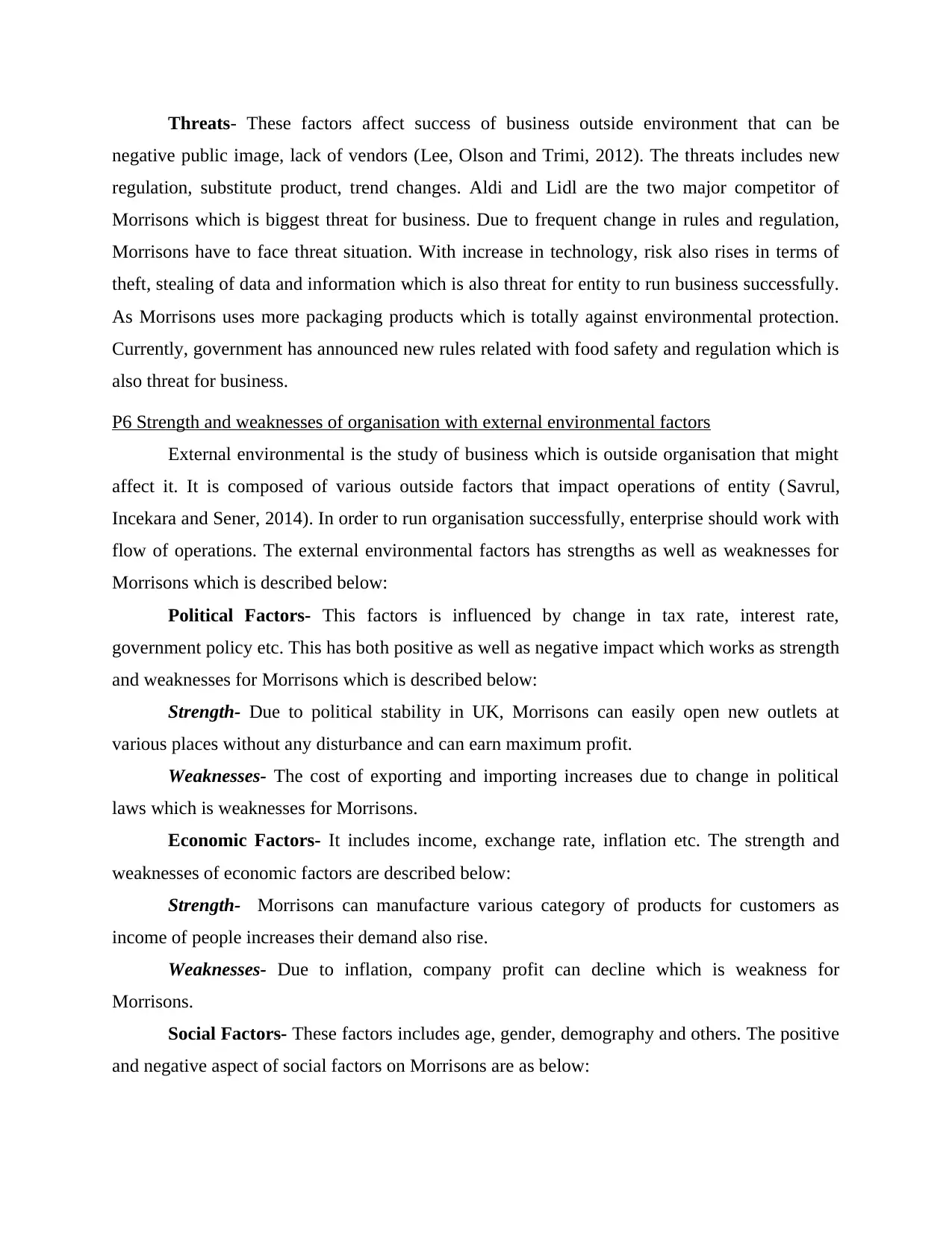
Threats- These factors affect success of business outside environment that can be
negative public image, lack of vendors (Lee, Olson and Trimi, 2012). The threats includes new
regulation, substitute product, trend changes. Aldi and Lidl are the two major competitor of
Morrisons which is biggest threat for business. Due to frequent change in rules and regulation,
Morrisons have to face threat situation. With increase in technology, risk also rises in terms of
theft, stealing of data and information which is also threat for entity to run business successfully.
As Morrisons uses more packaging products which is totally against environmental protection.
Currently, government has announced new rules related with food safety and regulation which is
also threat for business.
P6 Strength and weaknesses of organisation with external environmental factors
External environmental is the study of business which is outside organisation that might
affect it. It is composed of various outside factors that impact operations of entity (Savrul,
Incekara and Sener, 2014). In order to run organisation successfully, enterprise should work with
flow of operations. The external environmental factors has strengths as well as weaknesses for
Morrisons which is described below:
Political Factors- This factors is influenced by change in tax rate, interest rate,
government policy etc. This has both positive as well as negative impact which works as strength
and weaknesses for Morrisons which is described below:
Strength- Due to political stability in UK, Morrisons can easily open new outlets at
various places without any disturbance and can earn maximum profit.
Weaknesses- The cost of exporting and importing increases due to change in political
laws which is weaknesses for Morrisons.
Economic Factors- It includes income, exchange rate, inflation etc. The strength and
weaknesses of economic factors are described below:
Strength- Morrisons can manufacture various category of products for customers as
income of people increases their demand also rise.
Weaknesses- Due to inflation, company profit can decline which is weakness for
Morrisons.
Social Factors- These factors includes age, gender, demography and others. The positive
and negative aspect of social factors on Morrisons are as below:
negative public image, lack of vendors (Lee, Olson and Trimi, 2012). The threats includes new
regulation, substitute product, trend changes. Aldi and Lidl are the two major competitor of
Morrisons which is biggest threat for business. Due to frequent change in rules and regulation,
Morrisons have to face threat situation. With increase in technology, risk also rises in terms of
theft, stealing of data and information which is also threat for entity to run business successfully.
As Morrisons uses more packaging products which is totally against environmental protection.
Currently, government has announced new rules related with food safety and regulation which is
also threat for business.
P6 Strength and weaknesses of organisation with external environmental factors
External environmental is the study of business which is outside organisation that might
affect it. It is composed of various outside factors that impact operations of entity (Savrul,
Incekara and Sener, 2014). In order to run organisation successfully, enterprise should work with
flow of operations. The external environmental factors has strengths as well as weaknesses for
Morrisons which is described below:
Political Factors- This factors is influenced by change in tax rate, interest rate,
government policy etc. This has both positive as well as negative impact which works as strength
and weaknesses for Morrisons which is described below:
Strength- Due to political stability in UK, Morrisons can easily open new outlets at
various places without any disturbance and can earn maximum profit.
Weaknesses- The cost of exporting and importing increases due to change in political
laws which is weaknesses for Morrisons.
Economic Factors- It includes income, exchange rate, inflation etc. The strength and
weaknesses of economic factors are described below:
Strength- Morrisons can manufacture various category of products for customers as
income of people increases their demand also rise.
Weaknesses- Due to inflation, company profit can decline which is weakness for
Morrisons.
Social Factors- These factors includes age, gender, demography and others. The positive
and negative aspect of social factors on Morrisons are as below:
Paraphrase This Document
Need a fresh take? Get an instant paraphrase of this document with our AI Paraphraser
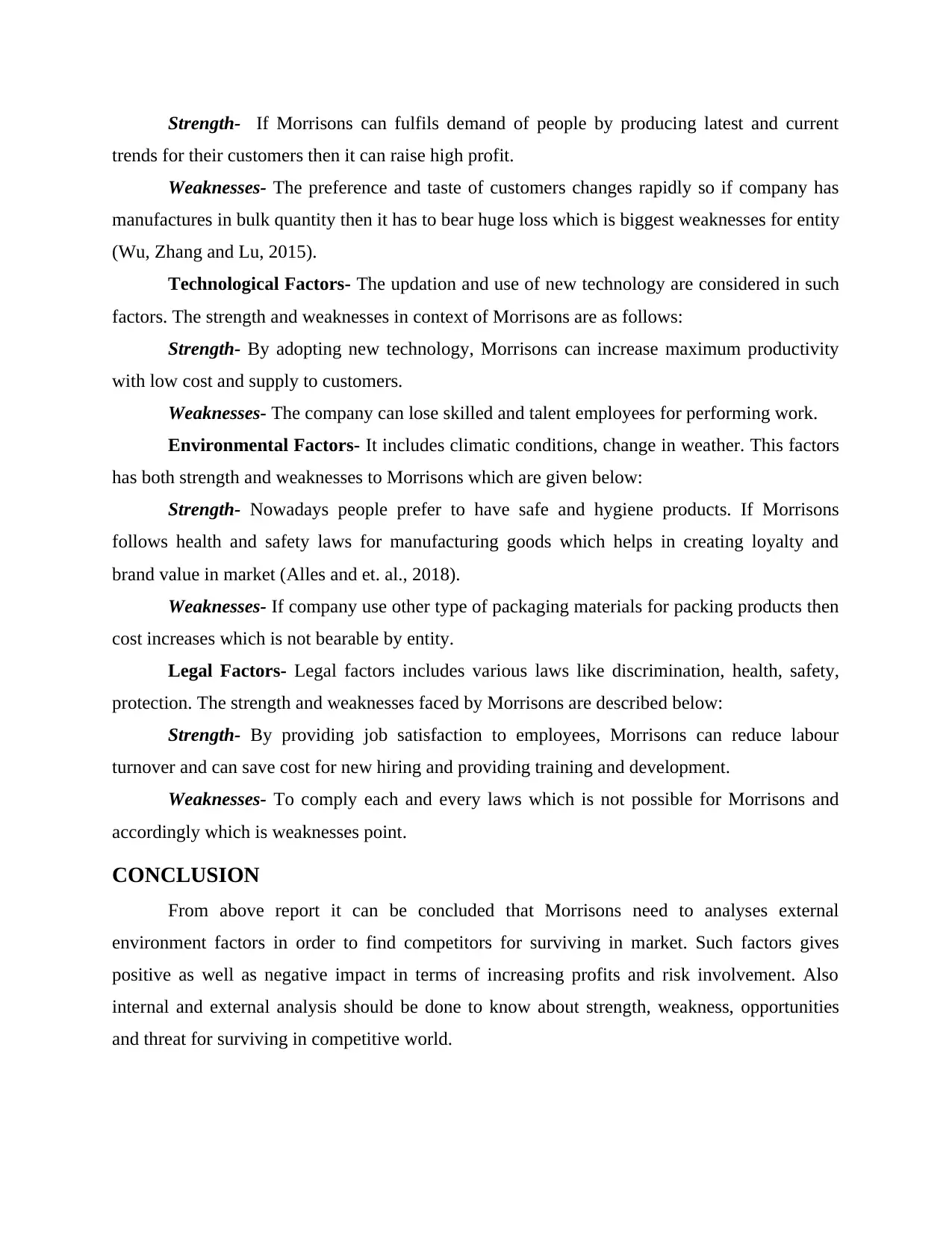
Strength- If Morrisons can fulfils demand of people by producing latest and current
trends for their customers then it can raise high profit.
Weaknesses- The preference and taste of customers changes rapidly so if company has
manufactures in bulk quantity then it has to bear huge loss which is biggest weaknesses for entity
(Wu, Zhang and Lu, 2015).
Technological Factors- The updation and use of new technology are considered in such
factors. The strength and weaknesses in context of Morrisons are as follows:
Strength- By adopting new technology, Morrisons can increase maximum productivity
with low cost and supply to customers.
Weaknesses- The company can lose skilled and talent employees for performing work.
Environmental Factors- It includes climatic conditions, change in weather. This factors
has both strength and weaknesses to Morrisons which are given below:
Strength- Nowadays people prefer to have safe and hygiene products. If Morrisons
follows health and safety laws for manufacturing goods which helps in creating loyalty and
brand value in market (Alles and et. al., 2018).
Weaknesses- If company use other type of packaging materials for packing products then
cost increases which is not bearable by entity.
Legal Factors- Legal factors includes various laws like discrimination, health, safety,
protection. The strength and weaknesses faced by Morrisons are described below:
Strength- By providing job satisfaction to employees, Morrisons can reduce labour
turnover and can save cost for new hiring and providing training and development.
Weaknesses- To comply each and every laws which is not possible for Morrisons and
accordingly which is weaknesses point.
CONCLUSION
From above report it can be concluded that Morrisons need to analyses external
environment factors in order to find competitors for surviving in market. Such factors gives
positive as well as negative impact in terms of increasing profits and risk involvement. Also
internal and external analysis should be done to know about strength, weakness, opportunities
and threat for surviving in competitive world.
trends for their customers then it can raise high profit.
Weaknesses- The preference and taste of customers changes rapidly so if company has
manufactures in bulk quantity then it has to bear huge loss which is biggest weaknesses for entity
(Wu, Zhang and Lu, 2015).
Technological Factors- The updation and use of new technology are considered in such
factors. The strength and weaknesses in context of Morrisons are as follows:
Strength- By adopting new technology, Morrisons can increase maximum productivity
with low cost and supply to customers.
Weaknesses- The company can lose skilled and talent employees for performing work.
Environmental Factors- It includes climatic conditions, change in weather. This factors
has both strength and weaknesses to Morrisons which are given below:
Strength- Nowadays people prefer to have safe and hygiene products. If Morrisons
follows health and safety laws for manufacturing goods which helps in creating loyalty and
brand value in market (Alles and et. al., 2018).
Weaknesses- If company use other type of packaging materials for packing products then
cost increases which is not bearable by entity.
Legal Factors- Legal factors includes various laws like discrimination, health, safety,
protection. The strength and weaknesses faced by Morrisons are described below:
Strength- By providing job satisfaction to employees, Morrisons can reduce labour
turnover and can save cost for new hiring and providing training and development.
Weaknesses- To comply each and every laws which is not possible for Morrisons and
accordingly which is weaknesses point.
CONCLUSION
From above report it can be concluded that Morrisons need to analyses external
environment factors in order to find competitors for surviving in market. Such factors gives
positive as well as negative impact in terms of increasing profits and risk involvement. Also
internal and external analysis should be done to know about strength, weakness, opportunities
and threat for surviving in competitive world.
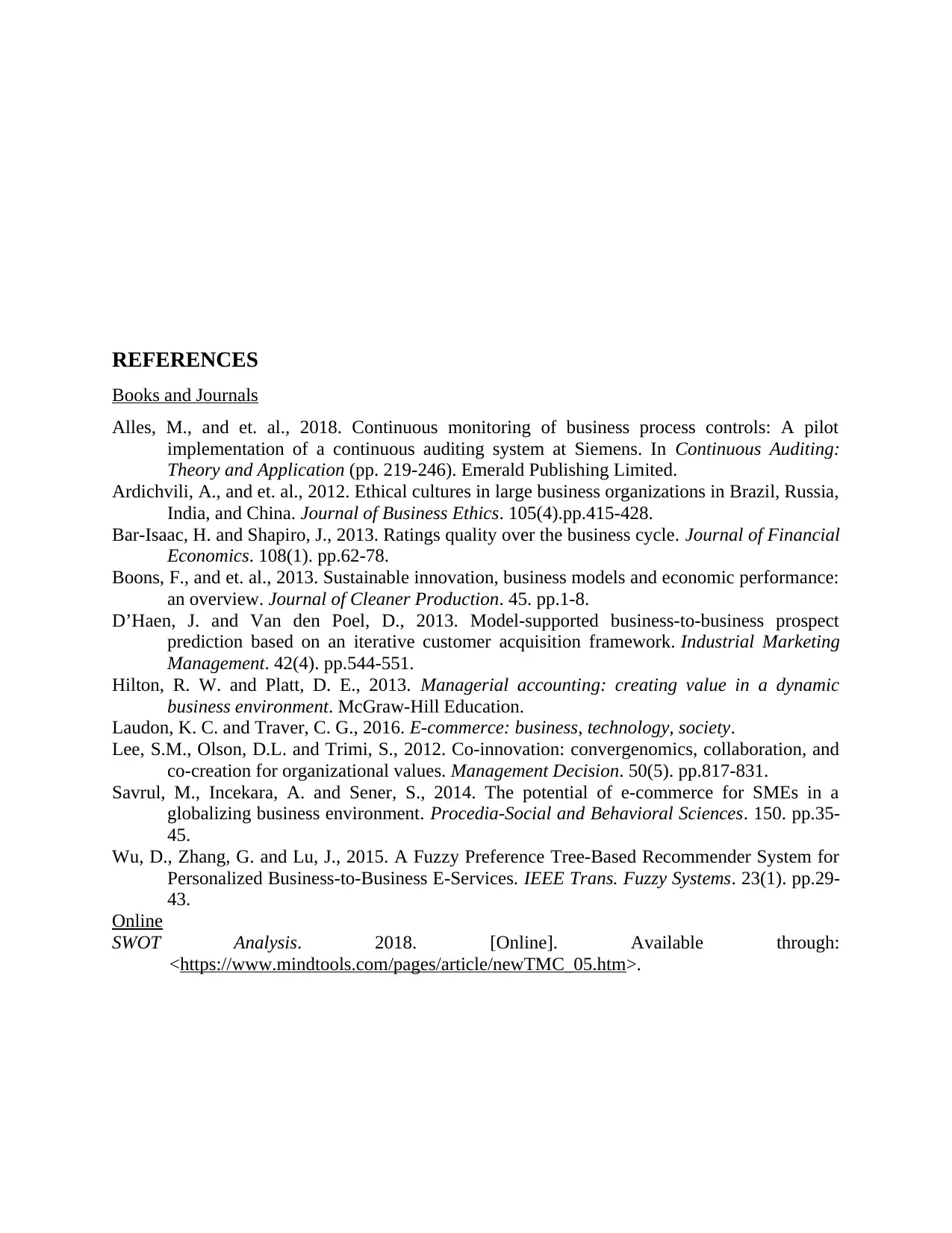
REFERENCES
Books and Journals
Alles, M., and et. al., 2018. Continuous monitoring of business process controls: A pilot
implementation of a continuous auditing system at Siemens. In Continuous Auditing:
Theory and Application (pp. 219-246). Emerald Publishing Limited.
Ardichvili, A., and et. al., 2012. Ethical cultures in large business organizations in Brazil, Russia,
India, and China. Journal of Business Ethics. 105(4).pp.415-428.
Bar-Isaac, H. and Shapiro, J., 2013. Ratings quality over the business cycle. Journal of Financial
Economics. 108(1). pp.62-78.
Boons, F., and et. al., 2013. Sustainable innovation, business models and economic performance:
an overview. Journal of Cleaner Production. 45. pp.1-8.
D’Haen, J. and Van den Poel, D., 2013. Model-supported business-to-business prospect
prediction based on an iterative customer acquisition framework. Industrial Marketing
Management. 42(4). pp.544-551.
Hilton, R. W. and Platt, D. E., 2013. Managerial accounting: creating value in a dynamic
business environment. McGraw-Hill Education.
Laudon, K. C. and Traver, C. G., 2016. E-commerce: business, technology, society.
Lee, S.M., Olson, D.L. and Trimi, S., 2012. Co-innovation: convergenomics, collaboration, and
co-creation for organizational values. Management Decision. 50(5). pp.817-831.
Savrul, M., Incekara, A. and Sener, S., 2014. The potential of e-commerce for SMEs in a
globalizing business environment. Procedia-Social and Behavioral Sciences. 150. pp.35-
45.
Wu, D., Zhang, G. and Lu, J., 2015. A Fuzzy Preference Tree-Based Recommender System for
Personalized Business-to-Business E-Services. IEEE Trans. Fuzzy Systems. 23(1). pp.29-
43.
Online
SWOT Analysis. 2018. [Online]. Available through:
<https://www.mindtools.com/pages/article/newTMC_05.htm>.
Books and Journals
Alles, M., and et. al., 2018. Continuous monitoring of business process controls: A pilot
implementation of a continuous auditing system at Siemens. In Continuous Auditing:
Theory and Application (pp. 219-246). Emerald Publishing Limited.
Ardichvili, A., and et. al., 2012. Ethical cultures in large business organizations in Brazil, Russia,
India, and China. Journal of Business Ethics. 105(4).pp.415-428.
Bar-Isaac, H. and Shapiro, J., 2013. Ratings quality over the business cycle. Journal of Financial
Economics. 108(1). pp.62-78.
Boons, F., and et. al., 2013. Sustainable innovation, business models and economic performance:
an overview. Journal of Cleaner Production. 45. pp.1-8.
D’Haen, J. and Van den Poel, D., 2013. Model-supported business-to-business prospect
prediction based on an iterative customer acquisition framework. Industrial Marketing
Management. 42(4). pp.544-551.
Hilton, R. W. and Platt, D. E., 2013. Managerial accounting: creating value in a dynamic
business environment. McGraw-Hill Education.
Laudon, K. C. and Traver, C. G., 2016. E-commerce: business, technology, society.
Lee, S.M., Olson, D.L. and Trimi, S., 2012. Co-innovation: convergenomics, collaboration, and
co-creation for organizational values. Management Decision. 50(5). pp.817-831.
Savrul, M., Incekara, A. and Sener, S., 2014. The potential of e-commerce for SMEs in a
globalizing business environment. Procedia-Social and Behavioral Sciences. 150. pp.35-
45.
Wu, D., Zhang, G. and Lu, J., 2015. A Fuzzy Preference Tree-Based Recommender System for
Personalized Business-to-Business E-Services. IEEE Trans. Fuzzy Systems. 23(1). pp.29-
43.
Online
SWOT Analysis. 2018. [Online]. Available through:
<https://www.mindtools.com/pages/article/newTMC_05.htm>.
1 out of 9
Related Documents
Your All-in-One AI-Powered Toolkit for Academic Success.
+13062052269
info@desklib.com
Available 24*7 on WhatsApp / Email
![[object Object]](/_next/static/media/star-bottom.7253800d.svg)
Unlock your academic potential
© 2024 | Zucol Services PVT LTD | All rights reserved.





